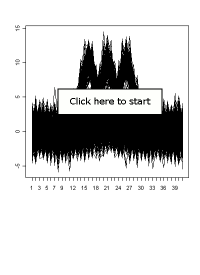Examples
Sommaire
More examples
Here are some extra examples on artificial data. For each, we give:
- A description of the longitudinal data (the mean trajectories of each clusters, the noise function, the number of trajectories in
each groups, number of mesurement,...).
- The graphical representation of the data
- The graphical represantation of the calinski criterions
- An example of execution
- The R code
Three diverging lines
Artificial data parameters
- Cluster Number : 3
- time = 0 to 7
| Groupe A | Groupe B | Groupe C |
| Clusters size | 60 | 50 | 40 |
| Trajectory shape |  |
 |  |
| Noise function |  |
 |  |
| Missing in each cluster | 0% | 0% | 0% |
Graphical representation, Calinski criterion and execution
Click on the picture to start the demonstration.
R code
dn1 <- generateArtificialLongData(
nbEachClusters=c(60,50,40),
functionNoise=function(t){rnorm(1,0,1.5)}
)
dn1 <- as.cld(dn1)
plot(dn1)
kml(dn1)
|
Three crossing lines
Artificial data parameters
- Cluster Number : 3
- time = 0 to 6
| Groupe A | Groupe B | Groupe C |
| Clusters size | 110 | 100 | 90 |
| Trajectory
shape |  |  |  |
| Noise function |  |  |  |
| Missing in each cluster | 0% | 0% | 0% |
Graphical representation, Calinski criterion and execution
Click on the picture to start the demonstration.
R code
dn2 <- generateArtificialLongData(
nbEachClusters=c(110,100,90),
functionClusters=list(function(t){2},function(t){10},function(t){12-2*t}),
functionNoise=function(t){rnorm(1,0,3)},
time=0:6
)
dn2 <- as.cld(dn2)
plot(dn2)
kml(dn2)
|
Four normal low
Artificial data parameters
- Cluster Number : 4
- time = 5 to 45
| Groupe A | Groupe B | Groupe C | Groupe D |
| Clusters size | 200 | 200 | 200 | 200 |
| Trajectory shape |
 |  |
 |  |
| Noise function |
 |  |
 |  |
| Missing in each cluster | 0% | 0% | 0% | 0% |
Graphical representation, Calinski criterion and execution
Click on the picture to start the demonstration.
R code
dn3 <- generateArtificialLongData(time=5:45,nbEachClusters=c(200,200,200,200),
functionCluster=list(
function(x){50*dnorm(x,20,2)},
function(x){50*dnorm(x,25,2)},
function(x){50*dnorm(x,30,2)},
function(x){25*dnorm(x,25,5)}
),
functionNoise=function(t){rnorm(1,0,1.5)}
)
dn3 <- as.cld(dn3)
plot(dn3)
kml(dn3)
|
Three lines and a polynome
Artificial data parameters
- Cluster Number : 4
- time = 0 to 10
| Groupe A | Groupe B | Groupe C | Groupe D |
| Clusters size | 100 | 100 | 100 | 100 |
| Trajectory shape |
 |  |
 |  |
| Noise function |
 |  |
 |  |
| Missing in each cluster | 0% | 0% | 0% | 0% |
Graphical representation, Calinski criterion and execution
Click on the picture to start the demonstration.
R code
dn4 <- generateArtificialLongData(
nbEachClusters=c(100,100,100,100),
functionClusters=list(
function(t){t},
function(t){0},
function(t){10-t},
function(t){-0.4*t^2+4*t}
),
functionNoise=function(t){rnorm(1,0,3)},
time=0:10
)
dn4 <- as.cld(dn4)
plot(dn4)
kml(dn4)
|
Three diverging lines with missing values
Artificial data parameters
- Cluster Number : 3
- time = 0 to 7
- Special: time 5, 10 and 15 considered as missing value.
| Groupe A | Groupe B | Groupe C |
| Clusters size | 60 | 50 | 40 |
| Trajectory shape |  |
 |  |
| Noise function |  |
 |  |
| Missing in each cluster | 30%+column(5,10,15) | 30%+column(5,10,15) | 30%+column(5,10,15) |
Graphical representation, Calinski criterion and execution
Click on the picture to start the demonstration.
R code
dn5 <- generateArtificialLongData(
functionClusters=list(
function(t){t/2},
function(t){0},
function(t){-t/2}
),
functionNoise=function(t){rnorm(1,0,3)},
nbEachClusters=c(100,100,100),
time=0:20,
percentOfMissing=c(0.3,0.3,0.3)
)
dn5 <- as.cld(dn5)
dn5@traj[,c(5,10,15)]<-NA
plot(dn5)
kml(dn5)
|
Two sinusoïdals
Artificial data parameters
- Cluster Number: 2
- time = 0 to 13
| Groupe A | Groupe B |
| Clusters size | 100 | 100 |
| Trajectory shape |  |  |
| Noise function |  |  |
| Missing in each cluster | 0% | 0% |
Graphical representation, Calinski criterion and execution
Click on the picture to start the demonstration.
R code
dn6 <- generateArtificialLongData(
nbEachClusters=rep(100,2),
functionClusters=list(
function(t){3*sin(t/2)},
function(t){6*sin(t)}
),
functionNoise=function(t){rnorm(1,0,3)},
time=0:13
)
dn6 <- as.cld(dn6)
plot(dn6)
kml(dn6)
|
Three diverging lines, high variance
In this example, the high variance makes that the groups are very closed. Artificial data is build with 3 groups, but kml find only two.
Artificial data parameters
- Cluster Number : 3
- time = 0 to 8
| Groupe A | Groupe B | Groupe C |
| Clusters size | 60 | 50 | 40 |
| Trajectory
shape |  |  |  |
| Noise function |  |  |  |
| Missing in each cluster | 30% | 30% | 30% |
Graphical representation, Calinski criterion and execution
Click on the picture to start the demonstration.
R code
dn7 <- generateArtificialLongData(
functionNoise=function(t){rnorm(1,0,5)},
nbEachClusters=c(100,100,100),
time=0:20
)
dn7 <- as.cld(dn7)
plot(dn7)
kml(dn7)
|

































































